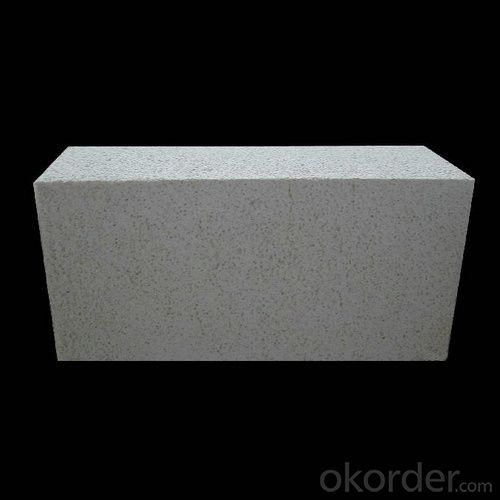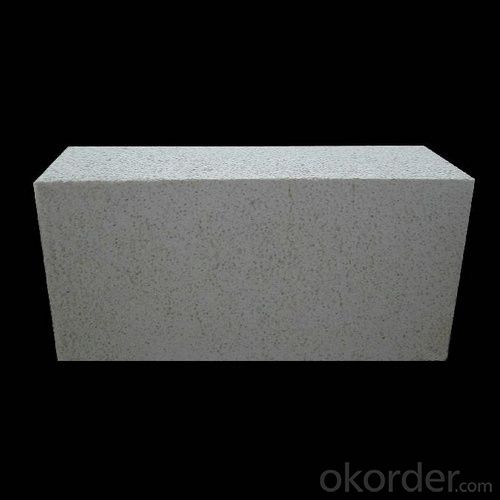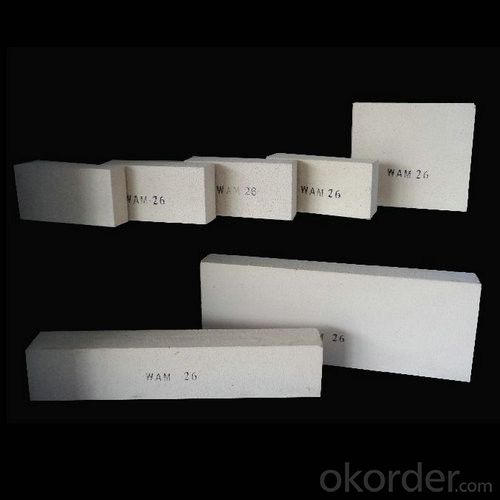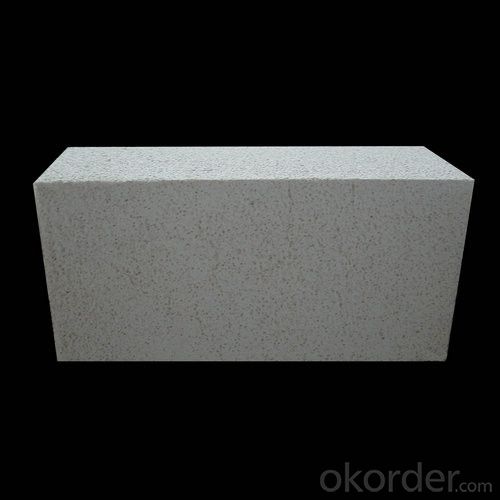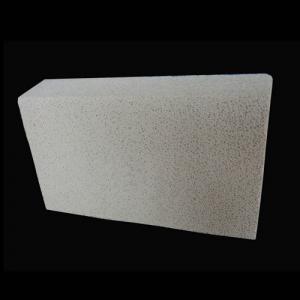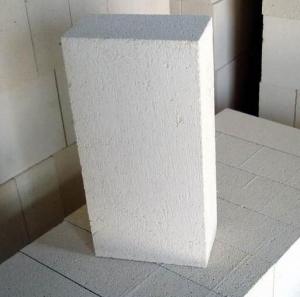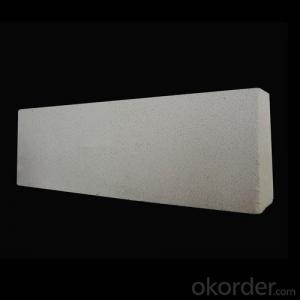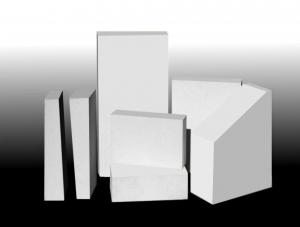Insulating Fire Brick (IFB) in GJM 23, 26, 30 Brands
- Loading Port:
- Shanghai
- Payment Terms:
- TT OR LC
- Min Order Qty:
- 100 pc
- Supply Capability:
- 2000000 pc/month
OKorder Service Pledge
OKorder Financial Service
You Might Also Like
General Information of Insulating Firebricks
CMAX insulating firebricks are classified under temperature between 1300℃ to 1700℃, manufactured from high purity alumina clay.
Image of Insulating Firebricks
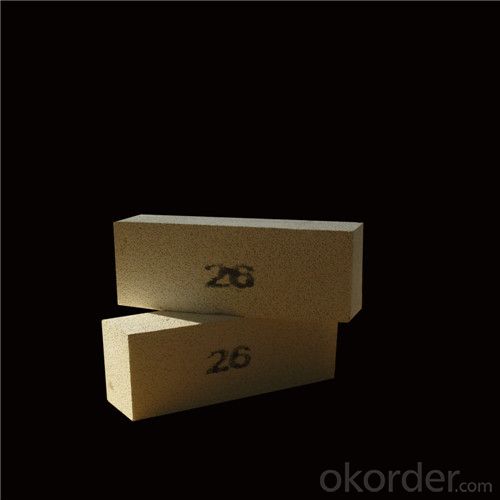
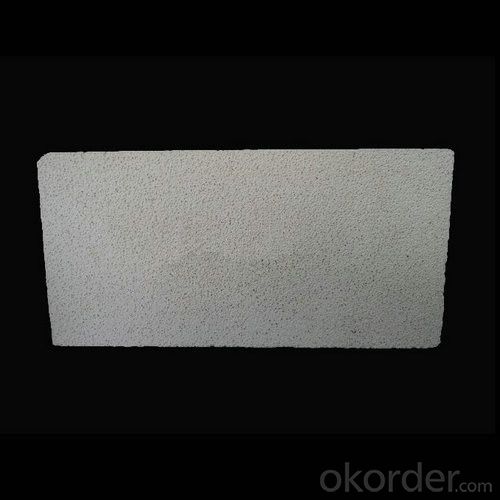
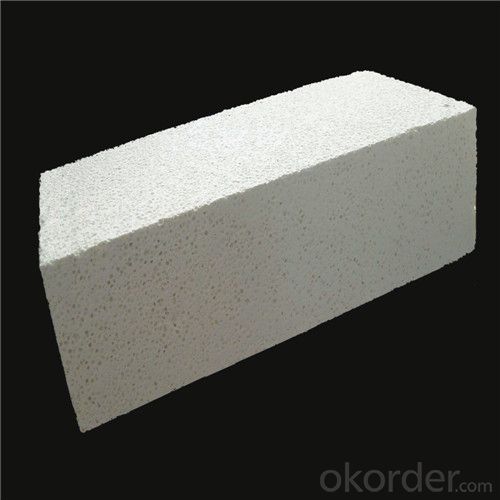
Technical Data of Insulating Firebricks
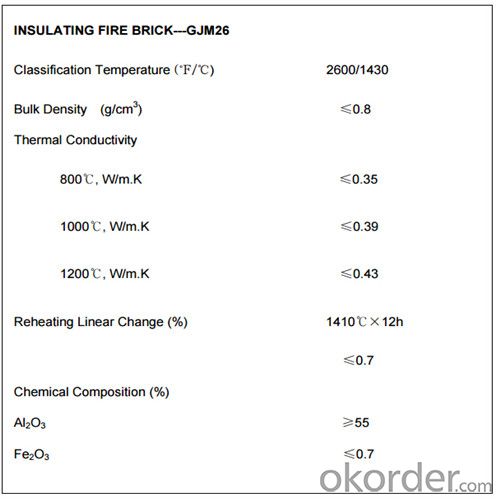
Feature of Insulating Firebricks
Light weight and low thermal conductivity
Low heat storage
Low iron and impurities
High thermal shock resistance
Application of Insulating Firebricks
CMAX insulating firebricks can be used as a hot face lining directly exposed to the heat or as a backup insulation layer in iron and steel mills, non-ferrous foundries, petrochemical, ceramic, glass.
Why Choose Us
l We are a government owned company with ISO certificate.
l We are listed in Global Fortune 500 with D & B report.
l We have more than 11 refractory production facilities and bases across China. We have a wide products range, such as ceramic fiber products (ceramic fiber blanket, module, board, paper, bulk), ceramic fiber textile (ceramic fiber rope, cloth, tape, yarn) etc, refractory brick (fireclay brick, high alumina brick, silica brick, magnesia brick etc), monolithic refractory materials, insulating fire brick, calcium silicate board, mica sheet, steel fiber. You can find various products here, and we can combine the light weight ceramic fiber products with the heavy weight refractory brick in one container delivery, then save the sea freight for you.
l We have strict materials selecting system and quality control system. We have the ability to take responsibility for your orders and product quality.
FAQ
Q1: How do you control the products quality?
A1: With strict quality control system throughout the materials selection and production process, our refractory and ceramic fiber products quality is effectively controlled to meet customer requirements.
From the raw materials selecting, our quality control begin. The quality certificates of raw materials are required and each batch will be tested before using. During production, the quality control are conducted by workers and then each piece will be sorted and examined by quality supervis
Q2: What`s the lead time for my order?
A2: It depends on customers’ requirements and our production schedule. And usually we need 30-60 days for refractory bricks,10-25 days for unshaped refractory materials and 10-20 days for ceramic fiber blankets.
Q3: Can you offer Door-to-Door delivery?
A3: Yes, but only for some countries such us U.S., UAE, Saudi Arabia, Iran, and Russia, etc.
Q4: What is the minimum quantity?
A4: There is no minimum order quantity. Depending on the item and processing, there may be a minimum production required, however we can offer a quotation based only on the quantity you need.
Q5: Can you give me a brief introduction of the application of your products?
A5: CNBM (China National Building Material) core refractory business comprises the production, sale and installation of high-grade refractory products, the development and implementation of customized system solutions as well as rendering outstanding services for the key industries in Glass, Iron& Steel, Petrochemical, Cement, Ceramic and Nonferrous Metals.
- Q: What is the typical modulus of rupture of an insulating fire brick?
- The typical modulus of rupture of an insulating fire brick is around 100 psi (pounds per square inch).
- Q: Can insulating fire bricks be used for sound insulation?
- No, insulating fire bricks are primarily designed for high-temperature applications such as lining furnaces, kilns, or fireplaces, and are not effective for sound insulation purposes.
- Q: What is mullite insulation brick?
- According to the application temperature can be divided into: 1350 mullite bricks, 1450 mullite bricks, 1550 mullite brick etc..
- Q: How do insulating fire bricks affect the overall fire resistance of a structure?
- The overall fire resistance of a structure is greatly enhanced by the presence of insulating fire bricks. These specialized bricks are designed to endure high temperatures and serve as an effective barrier against heat. By insulating the structure, they aid in minimizing heat transfer and the propagation of fire. The low thermal conductivity of insulating fire bricks allows them to resist heat transmission. This characteristic enables them to absorb and retain heat energy, preventing it from spreading to other parts of the structure. Consequently, the fire remains contained within a specific area, reducing the risk of it spreading to adjacent spaces. Additionally, insulating fire bricks possess a high melting point, rendering them highly resistant to heat. This quality enables them to endure prolonged exposure to intense temperatures without warping or disintegrating. By preserving their structural integrity, these bricks ensure the stability and overall integrity of the structure during a fire incident. Furthermore, insulating fire bricks serve as a barrier against flames and combustion gases. Their dense composition obstructs the passage of flames and smoke, preventing them from permeating the structure. This containment aids in limiting the damage caused by fire and provides occupants with valuable time to evacuate safely. In summary, the utilization of insulating fire bricks in constructing a structure significantly enhances its fire resistance. They provide insulation, prevent the propagation of fire, maintain structural stability, and act as a barrier against flames and smoke. By minimizing heat transfer and confining the fire, insulating fire bricks play a vital role in safeguarding the structure and its occupants during a fire emergency.
- Q: Can insulating fire bricks be used in the construction of aluminum smelting furnaces?
- Insulating fire bricks can indeed be utilized in the construction of aluminum smelting furnaces. These bricks are crafted from lightweight materials like refractory clay and possess exceptional insulating qualities. Consequently, they are well-suited for implementation in environments with elevated temperatures, such as aluminum smelting furnaces. By conserving heat and enhancing energy efficiency, they prove to be advantageous in these settings. Typically, aluminum smelting furnaces function at remarkably high temperatures, frequently exceeding 1000 degrees Celsius. In such extreme circumstances, insulating fire bricks serve as effective thermal insulation, thereby minimizing heat loss and sustaining the desired temperature inside the furnace. This insulation also contributes to reducing the energy required to heat the furnace, leading to cost savings and heightened efficiency. Furthermore, insulating fire bricks exhibit exceptional resistance to thermal shock. This quality enables them to endure rapid temperature variations without experiencing cracking or breakage. This characteristic holds significance in the context of an aluminum smelting furnace, where heating and cooling cycles can occur frequently and swiftly. In addition, insulating fire bricks possess low thermal conductivity, which is another advantage when employed in aluminum smelting furnaces. This property facilitates the retention of heat within the furnace, preventing it from dissipating into the surrounding environment. By diminishing heat loss, insulating fire bricks aid in maintaining a consistent temperature throughout the smelting process, ensuring optimal conditions for aluminum melting and refining. In summary, due to their remarkable insulating properties, resistance to thermal shock, and low thermal conductivity, insulating fire bricks constitute a suitable choice for constructing aluminum smelting furnaces. Their utilization contributes to enhanced energy efficiency, reduced heat loss, and the maintenance of a stable temperature inside the furnace.
- Q: What is the compressive strength of insulating fire bricks?
- The compressive strength of insulating fire bricks can vary depending on the specific composition and manufacturing process. However, in general, insulating fire bricks have a compressive strength ranging from 1 MPa (megapascal) to 10 MPa. This range is relatively low compared to other types of bricks due to their lightweight and porous nature, which is designed to provide excellent thermal insulation properties. It is important to note that the compressive strength of insulating fire bricks may not be as crucial as in structural bricks, as their main function is to provide insulation rather than structural support.
- Q: Are insulating fire bricks resistant to carbon dioxide?
- Insulating fire bricks, also known as refractory bricks, are engineered for withstanding high temperatures and displaying resistance to various chemicals and gases. Nonetheless, the level of resistance to carbon dioxide may differ based on the particular type and composition of the insulating fire brick. Carbon dioxide (CO2) is an inert gas usually found in the atmosphere and released when carbon-based fuels are burned. Typically, insulating fire bricks exhibit high resistance to carbon dioxide due to their elevated melting point and the presence of refractory materials like alumina and silica. Nevertheless, extended exposure to high concentrations of carbon dioxide, especially at increased temperatures, may lead to chemical reactions in some insulating fire bricks, resulting in degradation or diminished performance. Therefore, it is crucial to consider the specific application and environment in which the insulating fire bricks will be utilized. If the insulating fire bricks are part of a furnace or kiln that generates substantial amounts of carbon dioxide, it is advisable to select bricks explicitly designed for such conditions. These bricks might possess additional protective coatings or enhanced chemical resistance to ensure their durability and performance. To summarize, although insulating fire bricks generally possess good resistance to carbon dioxide, it is imperative to consider the specific type of brick and the conditions in which it will be employed to guarantee optimal performance and durability.
- Q: Do insulating fire bricks have a high electrical resistivity?
- Insulating fire bricks are generally characterized by their high electrical resistivity. This characteristic arises from their specific design, which aims to minimize thermal conductivity and maximize thermal resistance. Consequently, the insulating materials employed in these bricks, including alumina, silica, and other refractory materials, exhibit inherently high electrical resistivity. Moreover, the manufacturing procedures frequently incorporate the incorporation of insulating additives, thereby augmenting the electrical resistivity of the fire bricks. Consequently, insulating fire bricks prove to be highly effective in mitigating heat transfer and sustaining elevated temperatures across diverse industrial applications, such as kilns, furnaces, and thermal insulation systems.
- Q: Are insulating fire bricks resistant to insects and rodents?
- Insulating fire bricks do not have a specific design to resist insects and rodents. Although these bricks are mainly utilized for their exceptional thermal insulation properties in high-temperature settings like furnaces and kilns, they lack inherent resistance against pests. In case you have worries about insects or rodents, it is advisable to incorporate supplementary pest control methods such as sealing gaps or cracks and employing suitable pest deterrents.
- Q: Are insulating fire bricks suitable for high-temperature kilns?
- Yes, insulating fire bricks are suitable for high-temperature kilns. They are specifically designed to withstand extreme temperatures, making them an ideal choice for insulation in kilns. These bricks are made from lightweight refractory materials that have excellent thermal conductivity properties, allowing them to effectively retain heat and minimize heat loss. Additionally, insulating fire bricks have high resistance to thermal shock, ensuring their durability and longevity in high-temperature environments.
Send your message to us
Insulating Fire Brick (IFB) in GJM 23, 26, 30 Brands
- Loading Port:
- Shanghai
- Payment Terms:
- TT OR LC
- Min Order Qty:
- 100 pc
- Supply Capability:
- 2000000 pc/month
OKorder Service Pledge
OKorder Financial Service
Similar products
Hot products
Hot Searches
Related keywords








